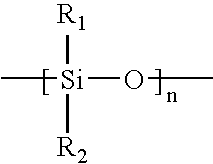Novel Polymers
a polymer and macromonomer technology, applied in the field of polymer polymerization, can solve the problems of complex first copolymerization step, sometimes suffering from the drawbacks described above affecting the quality of the resulting product,
- Summary
- Abstract
- Description
- Claims
- Application Information
AI Technical Summary
Benefits of technology
Problems solved by technology
Method used
Image
Examples
example 1
Preparation of a PDMS Crosslinker
[0156]In a 4-L beaker, 24.13 g of Na2CO3, 80 g of NaCl and 1.52 kg of deionized water are mixed to dissolve. In a separate 4-L beaker, 700 g of bis-3-aminopropyl-polydimethylsiloxane (Shin-Etsu, MW ca. 11500) are dissolved in 1000 g of hexane. A 4-L reactor is equipped with overhead stirring with turbine agitator and a 250-mL addition funnel with micro-flow controller. The two solutions are then charged to the reactor, and mixed for 15 minutes with heavy agitation to produce an emulsion. 14.5 g of acryloyl chloride are dissolved in 100 mL of hexane and charged to the addition funnel. The acryloyl chloride solution is added dropwise to the emulsion under heavy agitation over one hour. The emulsion is stirred for 30 minutes on completion of the addition and then agitation is stopped and the phases are allowed to separate overnight. The aqueous phase is decanted and the organic phase is washed twice with a mixture of 2.0 kg of 2.5% NaCl dissolved in wat...
example 2
Preparation of a PDMS Crosslinker
[0157]In a 4-L beaker, 61.73 g of Na2CO3, 80 g of NaCl and 1.52 kg of deionized water are mixed to dissolve. In a separate 4-L beaker, 700 g of bis-3-aminopropyl-polydimethylsiloaxane (Shin-Etsu, MW ca. 4500) are dissolved in 1000 g of hexane. A 4-L reactor is equipped with overhead stirring with turbine agitator and a 250-mL addition funnel with micro-flow controller. The two solutions are then charged to the reactor, and mixed for 15 minutes with heavy agitation to produce an emulsion. 36.6 g of acryloyl chloride is dissolved in 100 mL of hexane and charged to the addition funnel. The acryloyl chloride solution is added dropwise to the emulsion under heavy agitation over one hour. The emulsion is stirred for 30 minutes on completion of the addition and then agitation is stopped and the phases are allowed to separate overnight. The aqueous phase is decanted and the organic phase is washed twice with a mixture of 2.0 kg of 2.5% NaCl dissolved in wate...
example 3
Comparative Example
A. Preparation of the Crosslinkable Copolymer
[0158]A 2-L jacketed reactor is equipped with a heating / chilling loop, septum inlet adapter, reflux condenser with N2-inlet adapter, and overhead stirring. A solution is generated by dissolving 48.76 g of the PDMS crosslinker produced by the procedure described in Example 1 and 17.71 g of PDMS crosslinker produced by the procedure described in Example 2 in 150 g of 1-propanol. This solution is charged to the reactor and cooled to 8° C. The solution is degassed by evacuating to less than 5 mBar, holding at vacuum for 15 minutes, and then re-pressurizing with dry nitrogen. This degas procedure is repeated for a total of 5 times.
[0159]In a separate 500 mL flask equipped with magnetic stirring and a vacuum-inlet adapter with valve, 1.93 g of cysteamine hydrochloride are dissolved in 300 mL of 1-propanol. In another 500 mL flask equipped with magnetic stirring and vacuum-inlet adapter with valve, a solution of 31.27 g of N,N...
PUM
| Property | Measurement | Unit |
|---|---|---|
| temperature | aaaaa | aaaaa |
| molecular weights | aaaaa | aaaaa |
| size | aaaaa | aaaaa |
Abstract
Description
Claims
Application Information
 Login to View More
Login to View More - R&D
- Intellectual Property
- Life Sciences
- Materials
- Tech Scout
- Unparalleled Data Quality
- Higher Quality Content
- 60% Fewer Hallucinations
Browse by: Latest US Patents, China's latest patents, Technical Efficacy Thesaurus, Application Domain, Technology Topic, Popular Technical Reports.
© 2025 PatSnap. All rights reserved.Legal|Privacy policy|Modern Slavery Act Transparency Statement|Sitemap|About US| Contact US: help@patsnap.com



